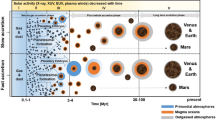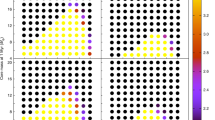Abstract
In this review paper I address the current knowledge of the formation of Mars, focusing on its primary constituents, its formation time scale and its small mass compared to Earth and Venus. I argue that the small mass of Mars requires the terrestrial planets to have formed from a narrow annulus of material, rather than a disc extending to Jupiter. The truncation of the outer edge of the disc was most likely the result of giant planet migration, which kept Mars’ mass small. From cosmochemical constraints it is argued that Mars formed in a couple of million years and is essentially a planetary embryo that never grew to a full-fledged planet. This is in agreement with the latest dynamical models. Most of Mars’ building blocks consists of material that formed in the 2 AU to 3 AU region, and is thus more water-rich than that accreted by Earth and Venus. The putative Mars could have consisted of 0.1 % to 0.2 % by mass of water.








Similar content being viewed by others
References
R.M. Canup, Dynamics of lunar formation. Annu. Rev. Astron. Astrophys. 42, 441–475 (2004)
J.E. Chambers, Making more terrestrial planets. Icarus 152, 205–224 (2001)
J.E. Chambers, A semi-analytic model for oligarchic growth. Icarus 180, 496–513 (2006)
J.E. Chambers, P. Cassen, The effects of nebula surface density profile and giant-planet eccentricities on planetary accretion in the inner solar system. Meteoritics and Planetary. Science 37, 1523–1540 (2002)
J.N. Cuzzi, R.C. Hogan, K. Shariff, Toward planetesimals: dense chondrule clumps in the protoplanetary Nebula. Astrophys. J. 687, 1432–1447 (2008)
N. Dauphas, A. Pourmand, Hf-W-Th evidence for rapid growth of Mars and its status as a planetary embryo. Nature 473, 489–492 (2011)
R. Greenberg, W.K. Hartmann, C.R. Chapman, J.F. Wacker, Planetesimals to planets—numerical simulation of collisional evolution. Icarus 35, 1–26 (1978)
P. Goldreich, S. Tremaine, Disk-satellite interactions. Astrophys. J. 241, 425–441 (1980)
N. Haghighipour, A.P. Boss, On gas drag-induced rapid migration of solids in a nonuniform solar nebula. Astrophys. J. 598, 1301–1311 (2003)
B.M.S. Hansen, Formation of the terrestrial planets from a narrow annulus. Astrophys. J. 703, 1131–1140 (2009)
S. Ida, J. Makino, Scattering of planetesimals by a protoplanet—slowing down of runaway growth. Icarus 106, 210 (1993)
S. Ida, D.N.C. Lin, Toward a deterministic model of planetary formation. IV. Effects of type I migration. Astrophys. J. 673, 487–501 (2008)
A. Johansen, J.S. Oishi, M.-M. Mac Low, H. Klahr, T. Henning, A. Youdin, Rapid planetesimal formation in turbulent circumstellar disks. Nature 448, 1022–1025 (2007)
T. Kleine, M. Touboul, B. Bourdon, F. Nimmo, K. Mezger, H. Palme, S.B. Jacobsen, Q.-Z. Yin, A.N. Halliday, Hf-W chronology of the accretion and early evolution of asteroids and terrestrial planets. Geochim. Cosmochim. Acta 73, 5150–5188 (2009)
E. Kokubo, S. Ida, Orbital evolution of protoplanets embedded in a swarm of planetesimals. Icarus 114, 247–257 (1995)
E. Kokubo, S. Ida, Oligarchic growth of protoplanets. Icarus 131, 171–178 (1998)
E. Kokubo, J. Kominami, S. Ida, Formation of terrestrial planets from protoplanets. I. Statistics of basic dynamical properties. Astrophys. J. 642, 1131–1139 (2006)
J. Kominami, S. Ida, The effect of tidal interaction with a gas disk on formation of terrestrial planets. Icarus 157, 43–56 (2002)
J. Kominami, S. Ida, Formation of terrestrial planets in a dissipating gas disk with Jupiter and Saturn. Icarus 167, 231–243 (2004)
K. Lodders, An oxygen isotope mixing model for the accretion and composition of rocky planets. Space Sci. Rev. 92, 341–354 (2000)
F. Masset, M. Snellgrove, Reversing type II migration: resonance trapping of a lighter giant protoplanet. Mon. Not. R. Astron. Soc. 320, L55–L59 (2001)
F.S. Masset, A. Morbidelli, A. Crida, J. Ferreira, Disk surface density transitions as protoplanet traps. Astrophys. J. 642, 478–487 (2006)
A. Morbidelli, J. Chambers, J.I. Lunine, J.M. Petit, F. Robert, G.B. Valsecchi, K.E. Cyr, Source regions and time scales for the delivery of water to Earth. Meteoritics and Planetary. Science 35, 1309–1320 (2000)
A. Morbidelli, A. Crida, The dynamics of Jupiter and Saturn in the gaseous protoplanetary disk. Icarus 191, 158–171 (2007)
A. Morbidelli, K. Tsiganis, A. Crida, H.F. Levison, R. Gomes, Dynamics of the giant planets of the solar system in the gaseous protoplanetary disk and their relationship to the current orbital architecture. Astron. J. 134, 1790–1798 (2007)
A. Morbidelli, R. Brasser, R. Gomes, H.F. Levison, K. Tsiganis, Evidence from the asteroid belt for a violent past evolution of Jupiter’s orbit. Astron. J. 140, 1391–1401 (2010)
A. Morbidelli, J.I. Lunine, D.P. O’Brien, S.N. Raymond, K.J. Walsh, Building terrestrial planets. Annu. Rev. Earth Planet. Sci. 40, 251–275 (2012)
M. Murakami, K. Hirose, H. Yurimoto, S. Nakashima, N. Takafuji, Water in Earth’s lower mantle. Science 295, 1885–1887 (2002)
F. Nimmo, T. Kleine, How rapidly did Mars accrete? Uncertainties in the Hf W timing of core formation. Icarus 191, 497–504 (2007)
D.P. O’Brien, A. Morbidelli, H.F. Levison, Terrestrial planet formation with strong dynamical friction. Icarus 184, 39–58 (2006)
D.P. O’Brien, K.J. Walsh, A. Morbidelli, S.N. Raymond, A.M. Mandell, J.C. Bond, Early giant planet migration in the solar system: geochemical and cosmochemical implications for terrestrial planet formation. Bull. Am. Astron. Soc. 42, 948 (2010)
J. Papaloizou, D.N.C. Lin, On the tidal interaction between protoplanets and the primordial solar nebula. I—Linear calculation of the role of angular momentum exchange. Astrophys. J. 285, 818–834 (1984)
R.O. Pepin, On the origin and early evolution of terrestrial planet atmospheres and meteoritic volatiles. Icarus 92, 2–79 (1991)
P.N. Peplowski et al., Radioactive elements on Mercury’s surface from MESSENGER: implications for the planet’s formation and evolution. Science 333, 1850 (2011)
A. Pierens, R.P. Nelson, Constraints on resonant-trapping for two planets embedded in a protoplanetary disc. Astron. Astrophys. 482, 333–340 (2008)
S.N. Raymond, T. Quinn, J.I. Lunine, High-resolution simulations of the final assembly of Earth-like planets I. Terrestrial accretion and dynamics. Icarus 183, 265–282 (2006)
S.N. Raymond, D.P. O’Brien, A. Morbidelli, N.A. Kaib, Building the terrestrial planets: constrained accretion in the inner Solar System. Icarus 203, 644–662 (2009)
V.S. Safronov, E.V. Zvjagina, Relative sizes of the largest bodies during the accumulation of planets. Icarus 10, 109 (1969)
D.D. Sasselov, M. Lecar, On the snow line in dusty protoplanetary disks. Astrophys. J. 528, 995–998 (2000)
K.J. Walsh, A. Morbidelli, S.N. Raymond, D.P. O’Brien, A.M. Mandell, A low mass for mars from Jupiter’s early gas-driven migration. Nature 475, 206–209 (2011)
S.J. Weidenschilling, J.N. Cuzzi, Formation of planetesimals in the solar nebula. Protostars Planets III, 1031–1060 (1993)
G. Wurm, J. Blum, J.E. Colwell, NOTE: a new mechanism relevant to the formation of planetesimals in the solar nebula. Icarus 151, 318–321 (2001)
Acknowledgements
The author is grateful to Germany’s Helmholtz Alliance for partially funding this research through their ‘Planetary Evolution and Life’ programme while still based in France. I thank Kevin Walsh and Alessandro Morbidelli for their input, David O’Brien and Tilman Spohn for constructive reviews, and Kevin Walsh and David O’Brien again for providing me with data from their numerical simulations.




